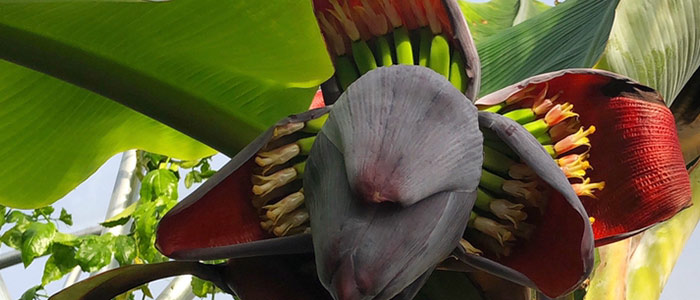- Shop
- Apparel
- Berries
- Books
- Bundles
- Citrus
- Fertilizer & Pest Control
- Fruiting Ground Covers
- Fruiting Shrubs
- Fruiting Trees
- Herbs, Spices, and Teas
- Mason Bees
- Nitrogen Fixers and Companion Plants
- Northwest Natives
- Nut Trees
- Ornamentals & More
- Perennial Vegetables
- Rootstock
- Subtropical Fruits
- Tools
- Vines
- Xeriscape
- Sale Items
- Information
- Nursery News
- Contact Us
- My Account

Grow Tropical Fruit in Any Location!
The taste of banana, guava, or pineapple can quickly transport any imagination to a warm, sunny location, lounging on a beach, and sipping margaritas. Tropical flavors aren’t usually available to us here in the north, but many subtropical plants grow quite easily here if given some winter protection.
Now is the time to expand the possibilities of where tropical plants can grow! Overwintering properly and planting in containers can bring the tropical harvest right into your very own home. Whether you are located in a colder region of the Midwest and East Coast or more temperate areas of the Pacific Northwest and California, a tropical fruit oasis is within reach!
Tips for Growing Tropical Fruit Trees:
1. Sun is a tropical fruit tree’s best friend. Choose a location where the plant will receive as much sunlight as possible indoors. A south facing window is recommended, and if a sunny location isn’t possible then grow lights are certainly an option and can be easily implemented. They also help elevate your mood in the dark days of winter! Some tropical plant varieties are somewhat cold hardy so be sure to check the USDA Hardiness Zone the plant is best suited for since you may have the pleasure of growing it outdoors year round. If they’re hardy outdoors then choose a sunny location with as much protection from harsh winter winds as possible. Just be sure to mulch heavily for more tender species and locate in appropriate microclimates to help them overwinter.
2. Choose the right size container. It’s best to plant in a pot just one size up from its previous container to help regulate moisture and avoid pathogens that occur in soggy potting soil. Potting up into a smaller pot also creates more fine root hair development when the plant’s roots hit the side of the pot and often induces earlier fruit bearing.
3.Don’t let them get too cold. Tropical plants are happiest in a climate where the temperatures don’t often dip below 40° F. Most tropical and subtropical plants love the full UV conditions of living outdoors during the summer, but when evening temperatures begin dropping into the 40’s it’s usually time to move them indoors. You can bring them out again in spring when temperatures begin to reach the high 40’s or low 50’s at night.
4.Create a humid environment. Many of these plants come from very humid parts of the world. Especially in the Western United States, we often lack the humidity they’re used to. Spraying with water from a simple spray bottle a few times a day or throughout the week helps to keep leaf surface humidity high and wash off any dust that might accumulate on the stomata.
5. Plant in a well draining soil and fertilize when needed. Even though these plants are used to moisture it is essential that they still receive proper drainage, especially in the darker winter months. If planting in a pot, it is recommend to plant in an organic potting soil that contains at least 50% perlite, vermiculite, or coarse bark. Fertilize plants with an organic balanced fertilizer at least once a month in spring – summer and then lessen fertilizing during the cooler months. If growing the trees in ground then it is recommended to not fertilize once cooler weather arrives.
6. Pruning in summer is recommended to help encourage smaller size. Winter pruning results in more rapid and extensive growth once spring arrives. Summer pruning results in less regrowth and is a great time to trim back the tree for size and maintenance. It is always recommend to prune out any dead, damaged, or diseased branches and to prune according to size preference. Just remember not prune off any of the flowers or young fruits!
7. Enjoy the beautiful foliage and fruit bounty! The appealing foliage of tropical plants is reason enough to grow them indoors through the winter. The bold foliage of a banana, the interesting texture of a pineapple plant or the quirky personality of a guava bush can really light up a room and there’s something so exciting about getting these plants to fruit in our northerly climates. With proper care most of these plants will bear fruit in as little as 1-2 years!
